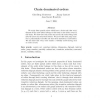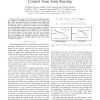76 search results - page 7 / 16 » Cartesian Partial-Order Reduction |
FMSD
2002
14 years 11 months ago
2002
Combining verification methods developed separately for software and hardware is motivated by the industry's need for a technology that would make formal verification of reali...
ORDER
2006
14 years 11 months ago
2006
We study finite partial orders which have a chain such that every element of the order either belongs to this chain or has all its covers in this chain. We show that such orders a...
APAL
2007
14 years 11 months ago
2007
A logic is developed in which function symbols are allowed to represent partial functions. It has the usual rules of logic (in the form of a sequent calculus) except that the subs...
CN
2000
14 years 11 months ago
2000
The dominant backbone protocol implemented in the Internet is the Border Gateway Protocol (BGP). Each router implementing BGP maintains a routing table. As networks increase in si...
IROS
2006
IEEE
15 years 5 months ago
2006
IEEE
— In this paper, we show that visual feedback reduces the complexity of parallel robot Cartesian control. Namely, 3D pose visual servoing, where the end-effector pose is indirect...


